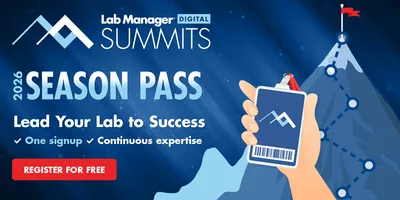Leadership often comes down to judging when you’ve got enough information to act. At the 2025 Lab Manager Leadership Summit, Alan Wells, MD, DMS, executive vice chairman of the department of pathology at the University of Pittsburgh Medical Center, explored the challenge of navigating incomplete, imprecise, and often conflicting data when a decision must be made.
During his session at the Summit, Wells:
- Explored where ambiguity arises in the lab,
- Explained the risks of over-analyzing data, and
- Shared a useful framework for making decisions in the face of uncertainty.
The nature of ambiguity in labs
As a scientist-turned-leader, your instincts may urge you to delay making a decision and continue gathering data. An unfortunate truth: the dataset will always be incomplete. There will, inevitably, be ambiguity present in the quantitative—and especially in the qualitative— data you collect.
Wells points out how ambiguity can arise from several sources. Measurements can be affected by pre-analytical, analytical, or post-analytical errors. Variability in how samples are collected can have downstream effects as well.
Even supposedly objective numbers have limitations. In one example Wells shared, a value close to a cut-off point may land on either side depending on the day or the device. Lab managers must recognize that confidence intervals, coefficients of variation, and rounding decisions can all obscure the true meaning of a number. In practice, these examples all point to the same fact: No data point is absolute.
The risks of over-analysis
Many leaders delay decisions, hoping additional data will provide clarity. But Wells warns that this reflex can be counterproductive—adding more data can introduce more variables and uncertainties.
He shared the example of the Space Shuttle Challenger disaster, in which the spacecraft exploded shortly after liftoff in 1986. In an effort to increase safety, engineers introduced 15,000 new parts. Each had a failure rate of only one in 10,000—but adding more parts still increased potential failure points. Instead of reducing risk, the added complexity made the system less reliable, Wells explained.
You have to define the outcome and the goal ahead of time
“Sometimes, adding more data to a dataset . . . introduces more variables, more areas of exception, and more uncertainty. So, the normal gut response of ‘I don’t have enough data to make a decision now,’ can backfire on you.”
In the lab, the same logic applies. “We often get into paralysis through analysis,” said Wells. The desire for perfect information can lead to endless rounds of review, preventing action altogether. Sometimes, it’s not that the data isn’t sufficient; it’s that the decision-maker is reluctant to accept ambiguity.
A strategic framework for decision-making
So, how should lab managers approach ambiguous decisions? Wells recommends using a qualitative cost-benefit framework. Instead of striving for certainty, weigh the potential benefits and deficits of each path against a goal you’ve already defined.
“You have to define the outcome and the goal ahead of time,” Wells stressed. Without a clearly articulated goal, you will unconsciously shift the goalposts of what constitutes sufficient, relevant data.
Wells then described three scenarios to illustrate how leaders can use strategic framing to guide their choices:
- Antibiotic resistance testing: Should labs rely solely on rapid molecular methods or keep conventional sensitivity testing? Rapid methods streamline workflows and shorten turnaround times but risk missing emerging antimicrobial resistance mechanisms. The decision depends on the tradeoff between lab efficiency and diagnostic accuracy.
- Critical values: What thresholds should be flagged for urgent notification? While more alerts may be annoying, under-calling critical values can threaten product quality, lab safety, and more. Wells advocated for erring on the side of caution.
- Estimated glomerular filtration rate (eGFR) and race adjustments: Early race-based adjustments aimed to improve drug dosing accuracy. However, these adjustments also inadvertently deprioritized some patients for kidney transplants. Ultimately, the cost to patient equity outweighed the benefit of dosing precision. The lesson? Even scientifically valid corrections can have unintended consequences.
These examples demonstrate that lab leaders must tailor their decisions to their specific goals—whether patient safety, operational efficiency, or ethical fairness. There is no one-size-fits-all solution, but framing the issue in terms of benefit and deficit helps clarify the path forward.
Ask, what do I need to make this less ambiguous—and can I actually get that?
Deciding when to move forward
At what point does further analysis stop helping and start hurting? Wells points out a clear sign: The moment when analysis becomes circular and no new insights emerge. Wells likens it to editing a manuscript: If you find yourself revising and then undoing the same changes, you've reached diminishing returns.
Lab Management Certificate
The Lab Management certificate is more than training—it’s a professional advantage.
Gain critical skills and IACET-approved CEUs that make a measurable difference.
Sometimes, you simply can't get the data you want. “Ask, what do I need to make this less ambiguous—and can I actually get that?” said Wells. If the answer is no, stop analyzing and act.
Knowing when to stop is especially critical under time pressure. Labs may need to launch a new LIMS, implement new QC standards, or choose between vendors on a tight schedule. In these moments, leaders must resist the urge to postpone and instead focus on making the best decision possible with what’s available.
Once a decision has been made, evaluate its outcomes against your original goals. Wells advises looking at key metrics to assess the outcome. While choosing the right metrics can be subjective, they should align with the intent of the decision, and they should be gathered from all levels—lab staff, administrators, and end users. This 360-degree view will give you the most complete picture of the outcome of the decision, informing future ones.
Ultimately, the most effective leaders aren’t those who wait for perfect clarity—they’re the ones who can rightly discern when to act and when to gather more data. And for scientists, Wells recommends approaching decisions like experiments, letting the outcome of each inform the next, thereby reducing the ambiguity.
In Wells’s words, “[In short, the takeaways] are to recognize that all your decisions are based on incomplete data. You have to have a framework that works for you, and you have to apply it consistently . . . [and] communicate effectively, clearly, and early.”













